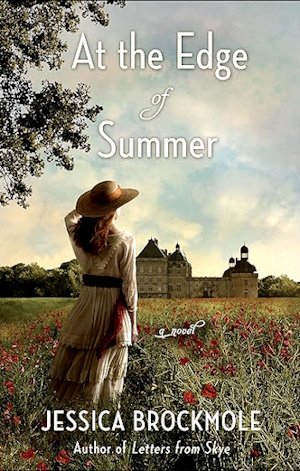“We’re not done with the world yet. Grandfather, we’re only here for the time being.”
He leaned back in his chair and sighed. “Forty-seven years,” he said again, his face creased with anguish.
I could see the hallway as he did, hung with paintings showing a brief, ecstatic marriage, framed around with a love that had never died.
“Art,” I said, “is a chance to capture a fleeting heart’s impression onto paper and canvas.” I rested my fingertips on his shoulders. “It’s a memory, caught up with charcoal, an emotion, caught up with paint. In a gallery like this, we’re not surrounded by ghosts. We’re surrounded by the chronicle of a life.”
“Then let me show you your mother’s.”
—
Mother’s pictures were so unlike anything that my grandmother or I did.
“Maud was a designer.” Charles Rennie Mackintosh set his glass of port carefully to the side of the table. “She designed furniture, mantelpieces, the most elegant end tables. She was brilliant.”
The sketches were all pen-and-ink, with clean, deliberate, yet fanciful lines, washed in with pale watercolors. A straight-armed dining chair with a back like a soaring castle. An end table crouched like a troll. A headboard curving across like a basilisk’s serpentine neck. Her designs, they were fairy tales brought to life in everyday objects.
“I never saw her create anything,” I said. “I thought she left that all behind in Glasgow.”
“She was prolific at the School of Art,” said Mr. Mackintosh. “Saw the world through a wistful glass. Everything that came from her pen was beautiful.” He nodded towards the drawings in my hands.
I handed him the stack, somewhat reluctantly. I’d only just found them, these drawings of my mother’s, these traces of her. She’d never shared them with me, no matter how often I had asked.
And yet Grandfather knew where to look for them. Up on top of Mother’s wardrobe, hidden by the crown molding, was a flat wooden box marked with my grandmother’s initials. “Where Maudie always hid things as a girl,” Grandfather told me. With the dust on top, the box might have been there since her wedding day.
They were old, but the colors still vibrant. “Ah, but she did good work.” Gently, Mr. Mackintosh turned through the pages. “But when her favorite instructor left, Maud lost something.” He paused at a sketch of a chair I swore I’d seen before. “It was as though she lost her confidence along with her mentor.”
I reached for the sketch. The chair was heavy, square, with carved dragons’ heads on the arms. I’d seen it before in a painting. A chair fit for a queen. “It was more than that,” I said softly. “She lost a friend.”
From his seat on the sofa, Grandfather watched.
“I introduced her to your father,” Mr. Mackintosh said. “I thought she’d begin drawing again. Designs to complement his buildings.”
“It was a good idea, lad,” Grandfather said, though the “lad” was as gray as he was.
“Did she ever build her designs?” I asked.
Grandfather shook his head. “Maud always said they were nothing but a lark.”
“Ah, but if she was still at the School of Art when I was working on Kate Cranston’s tea rooms!” Mr. Mackintosh was wistful. “If she was willing to see it as more than a lark!”
“As good as she was, she never took design seriously,” Grandfather said. “She always said it wasn’t ‘real art.’ She wanted to illustrate like Claude, sculpt like Rowena.”
Mr. Mackintosh harrumphed and picked up his port.
“This is as real as I’ve ever seen her.” I pulled over one of Mother’s sketches, a dining table with legs twining out from the floor like vines of roses. “This one, I think. It shows a piece that belongs so much that it grows from the house.” I handed it to Mr. Mackintosh.
He nodded. “I was going to suggest the same. Young Clare has an eye.”
Grandfather settled back onto the sofa with his pipe. “She does. You should see her work.”
Mr. Mackintosh lifted an eyebrow. “I shouldn’t be surprised. Maud’s daughter, of course you’d be drawing.”
“She draws, she paints. She’s even sculpted with clay from the banks of the Senegal River. Clare, run and get your portfolio.”
I wanted to tell my grandfather that I was too old to run, that we’d long since passed the stage where he could instruct me, that I didn’t even have a portfolio. But the small hopeful part of me that sent Luc the occasional drawing, just to see what his father had to say about it, that part of me went up to my room for the cracked leather case that had traveled Iberia and northern Africa clutched to my chest. That part of me held my breath while waiting for Mr. Mackintosh’s pronouncements.
He looked through the stack—charcoal sketches, oil paintings, soft watercolors of the sunrise over the desert—and then spoke directly to Grandfather. “Do you need help with her application?”
“It’s a good fit for her.”
“I can see the potential.”
“She’s had a little instruction.”
“I can see, but it’s raw and fumbling.”
“Still, it’s a good fit.”
“Please,” I broke in. “Are they really that bad? What’s a good fit?”
Mr. Mackintosh blinked. “The Glasgow School of Art. Your grandfather wishes to enroll you.”
I looked to Grandfather, whose eyes were already evasive. “You mean to be rid of me so that you can leave again.” I reached over the table, gathering up my drawings. “Well, I won’t go. Someone needs to take care of you.”
“Clare,” he protested, clapping his hands down on the painting nearest him, a fantasy piece I’d painted of Luc sitting in the curve of a Marrakesh doorway. “I’m not trying to rid myself of you. I’m trying to do what’s best for you.”
I tried to tug the paper from under his splayed palms, but it began to tear in the corner.

























